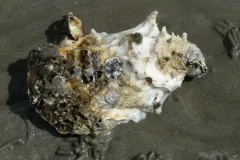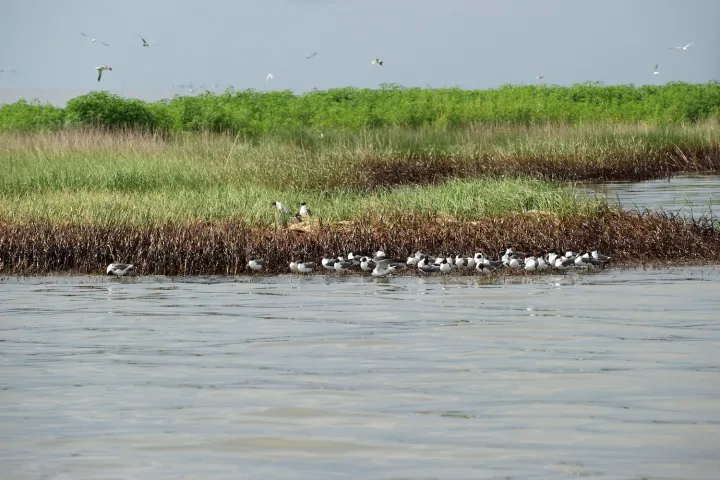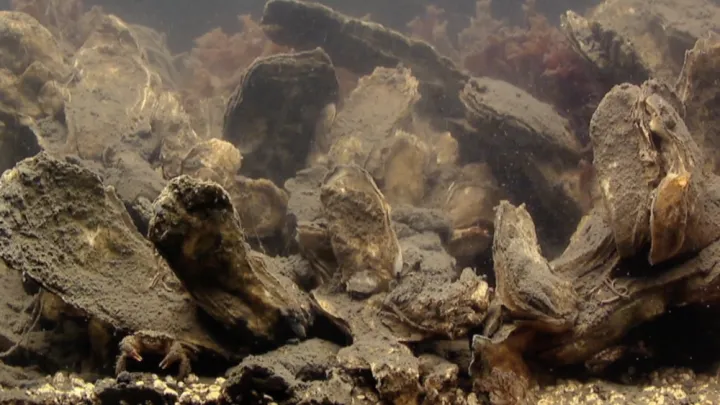How to Survive an Oil Spill: Oyster Edition

Oysters are powerhouses of water filtration. In a single day, one oyster can filter through 20 to 50 gallons, enough water to fill a small bathtub. This is how they eat, snagging tiny drifting particles. And so, as stationary creatures, it bodes well to live where ample food floats by. It also means that oysters must weather whatever hazards come their way.
Born from the fusion of a drifting egg and sperm spawned by their parents, a young oyster looks very different than the shelled mollusk shucked and slurped at summertime cookouts. Microscopic orbs with fuzzy, squashed hats, an oyster larva is subject to the whims of the tides and currents for the first few weeks of their lives, but once they’ve matured and settled on the seafloor, they’re stuck there for life.
An oil spill is one such hazard that threatened oyster beds along the Louisiana coast in 2010. The Deepwater Horizon oil spill released 3.19 million barrels of oil into the Gulf of Mexico after an explosion that took 11 human lives.
The combined effect of freshwater diversion release to try and deflect the oil from coming onshore and to a lesser extent oiling and cleanup measures likely killed about 8.3 million oysters along the shores of Louisiana. And so, scientists with the Alabama Center for Ecological Resilience (ACER), including Dr. Sean Powers from the University of South Alabama, decided to study what impacts oyster survival under different conditions in the waters affected by the Deepwater Horizon oil spill. Through several experiments, they found that an oyster survived or died based upon three key factors.
Salt
An oyster’s relationship with salt follows the Goldilocks principle—they prefer not too much, and not too little. In general, they thrive in coastal waters with a salinity level between 14 and 28 parts per thousand (ppt), a little less salty than the average 36 ppt of open ocean water. But life gets tough for an oyster when the salinity is too high or too low, and any extra stress (like oil) can set them over the edge. Or so scientists thought would be the case after an event like Deepwater Horizon.
What Powers and his team found in lab tests was actually the opposite. In one experiment, hatchery-grown oysters were placed in tanks where scientists could precisely regulate the environment with an inflow of salty water. Some oysters were allowed to live in tanks where the salt level was low, while others were allowed to live a life of comfort at about the level where oysters do best. After exposure to oil, what happened was a bit of a shock. The oysters that lived in the less salty, more stressful, environment actually fared better. About 70 percent of the oysters in the moderately salty tanks died, while only five percent died in the tanks with low salinity.
The thought is that oysters in low salt levels have reduced their feeding activity and are in a semi-comatose state—similar to when a bear is hibernating. The body shuts down any unnecessary activities so that it can focus on those that will keep it alive. For an oyster living in low salt water, their absorption mechanism was already operating at a sluggish pace and when the oil was added they weren’t moving fast enough to absorb the toxic substance.
Diversity
In oyster ecology, as in most aspects of life, diversity matters. In this scenario, we are talking about genetic diversity specifically. An oyster bed is filled with individuals with different parentage, meaning that oysters living next to one another have different versions of the same genes. It’s a similar idea to eye color—different versions of the same gene produce different eye colors. Now scale that principle to multiple genes and apply it to oyster traits, like shell strength.
An oyster bed is likely to survive if there is high genetic diversity, meaning the version of genes in each individual are different than those next to it. That way if one gene makes an oyster susceptible to dying in the face of a threat, those that have another version will live on.
“The more genetic diversity there is, the greater the chance that some of those oysters in that population can fight,” says Powers.
In the world of oyster research, obtaining oysters with diverse parentage is a matter of picking up the phone and ordering the flavor of your choosing from the local oyster hatchery. For this experiment, three groups of oysters were used. For one group, five males were paired with a female oyster and then each pair was placed in a separate tank at the moment of their spawning. The children of these oyster pairs will be considered group number one. For group number two, two males and two females from the children created in group number one were placed in a tank as they spawned. In the jumble of eggs and sperm, four different parentage combinations are possible. And finally, the third grouping used three males and three females from group number one, for a total of nine different parent possibilities.
In this case, having a bed of oysters with diverse parentage (and therefore diverse genetics) did allow for a slight survival advantage when exposed to oil.
Dispersant
When oil leaks into the ocean, it gloms into a giant mass at the surface (think of the layers in a bottle of salad dressing). This is because oil is both hydrophobic—it doesn’t mix well with water—and lighter than water. With large quantities of oil, these properties make it difficult for microbes in the water to quickly and efficiently break down oil into less toxic forms. To aid the breakup of oil so that microbes can do their job, scientists decided to add a chemical to the spill that would break up the oil mass into tiny droplets. While this chemical dispersant helps expose more of the oil to bacteria and waves which help to break it down, it also makes the oil more available to the oysters.
And this is what Powers and his team determined. The addition of dispersant to the moderate salinity experiment tanks led to a drastic increase in oyster death. Mortality of oysters exposed to both oil and dispersant was about 90 percent, compared to 70 percent when only oil was added.
The Future
We can only help oysters if we know how to keep them healthy. By understanding how even limited exposure to oil and dispersant affects oysters, we can better anticipate how future oil spills can harm oyster reefs, and we can take necessary steps to prevent this harm.
Although dispersant was not used within three miles of the coastline, Powers notes that there is often pressure from petroleum companies to use dispersant. Currently, states along the Gulf Coast have policies against using dispersant close to shore. “Obviously, this experiment shows that [policy] is a good idea,” says Powers.
In Louisiana, the marsh system was flushed with fresh water in an effort to keep the impending oil away from shore, but in the process, the very low salinity (near zero for months) killed many oysters. But perhaps a moderate flushing with the intent to slightly decrease the water salinity (to levels similar to those in the experiment) rather than physically drive away the oil would be the most advantageous to keeping oil away and protecting oysters.
“An idea that we thought was kinda silly—releasing freshwater into the system, turns out that at least in these experiments, it backs it up,” says Powers.
For the oysters that lived in the bay prior to Deepwater Horizon, it’s too late. But with a little guidance, perhaps in a future oil spill, we will be more prepared. It’s the least we can do for the oysters, which contribute so much to the care of our waters.
__________
Editor's Note: Danielle Hall contributed to the reporting of this story.
The Ocean Portal receives support from the Gulf of Mexico Research Initiative (GoMRI) to develop and share stories about GoMRI and oil spill science. The Gulf of Mexico Research Initiative (GoMRI) is a 10-year independent research program established to study the effect, and the potential associated impact, of hydrocarbon releases on the environment and public health, as well as to develop improved spill mitigation, oil detection, characterization, and remediation technologies.
For more information, visit http://gulfresearchinitiative.org



